Spotlight : September 1997
The Best of Boss
By Todd Vaziri
Spotlight : September 1997
The Best of Boss
By Todd Vaziri
When Richard Edlund founded Boss Film Studios fifteen years ago, he brought along his wealth of experience in optical compositing and his talent for storytelling to his infant company.
Edlund earned four Academy Awards for his pioneering work at Industrial Light & Magic--one from each of the STAR WARS movies and one for RAIDERS OF THE LOST ARK. Edlund supervised effects that had a magical, supernatural quality, from the ghostly images from POLTERGEIST to the wrath of the Ark's fury in RAIDERS OF THE LOST ARK. In founding Boss Film, he put together some of the finest talent in all of Hollywood to make a series of spectacular films.
Right out of the gate, Boss created fantastic imagery. Boss racked up a number of high-quality visual effects projects: 2010, for which optically composited space shots rivaled (if not surpassed) its predecessor; John Carpenter's BIG TROUBLE IN LITTLE CHINA, which included a grab bag of creature and optical effects; ALIEN 3 and SPECIES, which will be remembered for their pioneering use of motion-capture and CG animation; and this year's aerial double feature, TURBULENCE and AIR FORCE ONE. (For a complete list of Boss' credits, visit the VFX HQ's Boss Film Studios page.)
However, the two films Boss for which will most likely be remembered are Ivan Reitman's GHOSTBUSTERS from 1984, and 1988's DIE HARD, directed by John McTiernan. Both films were nominated for Academy Awards, and both films' visual effects take on a life of their own, while servicing the needs of the filmmaker to tell a story.
A series of terrific matte paintings represented the evil building where Gozer the Gozerian makes its return to earth. Optically composited into many shots was cloud tank footage, representing the development of evil cloud formations. Creature effects included the semi-transparent Slimer ghost, as well as the stop-motion animated librarian from the beginning of the film.
 Boss Film, before its announced closure on August 28, 1997, was one of the few houses in existence that could boast a pre-digital era. In fact, Boss will most likely be remembered for their wonderful work on some of the 1980's biggest effects films, all of which were created optically, long before the days of digital.
Boss Film, before its announced closure on August 28, 1997, was one of the few houses in existence that could boast a pre-digital era. In fact, Boss will most likely be remembered for their wonderful work on some of the 1980's biggest effects films, all of which were created optically, long before the days of digital.
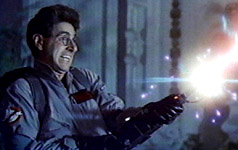 For their first big project, Boss was swarming with some of the hottest young talent ever organized for a single show. Supervising and executing the effects of GHOSTBUSTERS' voluminous matte paintings, optical composites, creature effects and model production was a group of artists and technicians that are currently a 'who's who' of effects. At art director, John Bruno, who went on to supervise CLIFFHANGER and THE ABYSS. Supervising the model shop, Mark Stetson, who just supervised THE FIFTH ELEMENT. Add into the mix Ed Jones (Cinesite), Ronald B. Moore ("Star Trek: TNG"), Robert Spurlock (Stetson Visual Services), Pat McClung (DANTE'S PEAK), and plenty of others who are now giants in the industry, it's no wonder that GHOSTBUSTERS turned out to be the visual extravaganza it is.
For their first big project, Boss was swarming with some of the hottest young talent ever organized for a single show. Supervising and executing the effects of GHOSTBUSTERS' voluminous matte paintings, optical composites, creature effects and model production was a group of artists and technicians that are currently a 'who's who' of effects. At art director, John Bruno, who went on to supervise CLIFFHANGER and THE ABYSS. Supervising the model shop, Mark Stetson, who just supervised THE FIFTH ELEMENT. Add into the mix Ed Jones (Cinesite), Ronald B. Moore ("Star Trek: TNG"), Robert Spurlock (Stetson Visual Services), Pat McClung (DANTE'S PEAK), and plenty of others who are now giants in the industry, it's no wonder that GHOSTBUSTERS turned out to be the visual extravaganza it is.
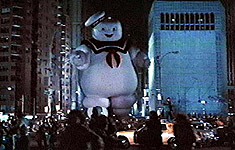
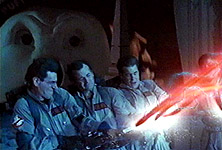
An immense amount of skyscraper miniatures were used for the spectacular climax of the film, where a gigantic Mr. Stay Puft takes a stroll in New York. The Boss trademark of terrific light effects and animation began in GHOSTBUSTERS with the stream effects emanated from the Ghostbusters nuclear accelerators.
Add into the mix the countless bluescreen composites, a good amount of stop-motion animation, and various optical tricks, and you have one hell of an effects film--a historic rookie effort for the young Boss Film Studios.
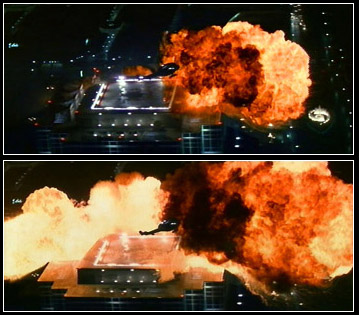 Four years later, Edlund supervised what has been regarded as the last, finest pre-digital visual effects show, DIE HARD, the explosive, action-packed film that gave birth to a new action genre, as well as raise the stakes in the quality of blockbuster visual effects. The film's effects originated on 65mm, and this higher standard certainly shows in the finished effects shots.
Four years later, Edlund supervised what has been regarded as the last, finest pre-digital visual effects show, DIE HARD, the explosive, action-packed film that gave birth to a new action genre, as well as raise the stakes in the quality of blockbuster visual effects. The film's effects originated on 65mm, and this higher standard certainly shows in the finished effects shots.
Boss invisibly composited explosions and smoke effects into live-action background plates, most notably during the sequence where John McClane (Bruce Willis) drops a load of explosives down the Nakatomi building's elevator shaft. The shots taken from outside the building include some totally realistic explosions and light effects, and the interior shots of Willis looking down the shaft included a forced perspective miniature and a lot of optical compositing of flash and explosion elements.
But the effects that people remember most from DIE HARD is the film's dramatic climax, the explosion of the roof of the Nakatomi building. In one shot of the sequence, Boss composited various shots of explosion footage onto a helicopter shot of the roof of the Nakatomi Center--a stunning, beautiful shot that easily measures up to today's most complicated digital composites. The subsequent helicopter explosion is also world-famous, and it represents one of Boss' most incredible shots ever created; a splendid mixture of the finest in miniature production, pyrotechnics and high-speed photography.
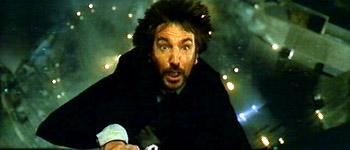 DIE HARD also included many bluescreen composites, including an updated version of Alfred Hitchcock's classic shot from SABOTEUR--Hans Gruber's slow motion thirty story plummet to the ground, taken from McClane's point of view. The shot looks terribly realistic. The camera does a slight tilt-down as Alan Rickman slowly falls from the top of the skyscraper. In reality, Rickman performed the stunt against a blue air pillow, 20 feet from the ground. His footage was then perfectly composited into live-action footage shot at the Century City Building in Los Angeles. The final composite is crisp and realistic... possibly one of the finest, longest optical bluescreen composites in history.
DIE HARD also included many bluescreen composites, including an updated version of Alfred Hitchcock's classic shot from SABOTEUR--Hans Gruber's slow motion thirty story plummet to the ground, taken from McClane's point of view. The shot looks terribly realistic. The camera does a slight tilt-down as Alan Rickman slowly falls from the top of the skyscraper. In reality, Rickman performed the stunt against a blue air pillow, 20 feet from the ground. His footage was then perfectly composited into live-action footage shot at the Century City Building in Los Angeles. The final composite is crisp and realistic... possibly one of the finest, longest optical bluescreen composites in history.
Boss built upon their successes and innovated the art and science of visual effects with nearly every picture they worked on. In 1992, they were honored with two nominations for Best Visual Effects at the Oscars for BATMAN RETURNS and ALIEN 3, both of which were completed with pioneering CG techniques. Their most incredible performance of the '90's is the wonderfully invisible effort for MULTIPLICITY, which was created with innovative uses of bluescreen and split-screen ingenuity.
Visual Effects by Boss Film Studios
Visual Effects by Boss Film Studios
Visual Effects Supervisor: RICHARD EDLUND
Visual Effects Art Director: JOHN BRUNO
Matte Painting Supervisor: NEIL KREPELA
Mechanical Effects Supervisor: THAINE MORRIS
Chief Cameraman: BILL NEIL
Model Shop Supervisor: MARK STETSON
Optical Supervisor: MARK VARGO
![]()
Visual Effects Supervisor: RICHARD EDLUND
Director of Photography: BILL NEIL
Visual Effects Editor: DENNIS MICHELSON
Visual Effects Art Director: BRENT BOATES
Optical Supervisor: CHRIS REGAN
Model Shop Supervisor: MARK STETSON
Matte Painting Supervisor: MATTHEW YURICICH
Chief Model Maker: PATRICK MCCLUNG
Back to more Boss Shuts Down articles...
Back to the Spotlight Main Menu

. . VFX HQ Produced by Todd Vaziri . . http://www.vfxhq.com . . e-mail: tvaziri@gmail.com . .
All text Copyright © 1998 Todd Vaziri, unless otherwise noted